中国传统文化英语翻译
- 格式:docx
- 大小:15.41 KB
- 文档页数:4
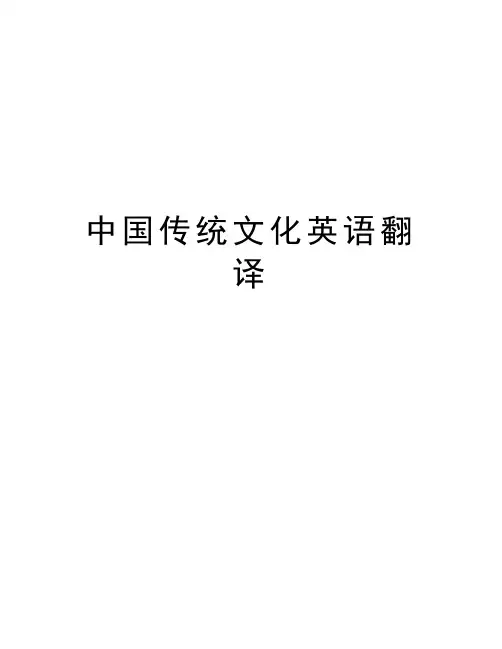
中国传统文化英语翻译1.香囊(scented sachet),古代也称“香袋”,通常是用布缝制或彩色丝线编织的袋子,里面塞满香草(aromatic herbs)。
香囊最初用来吸汗、驱虫和避邪。
香囊不仅有用,而且可作装饰品。
它们的形状和大小各异,有圆形、椭圆形和其他形状。
它们通常配有精致的图案,每个图案都象征着特别的含义。
例如,双鱼或成对蝴蝶图案象征男女之爱;莲花或牡丹花(peony flower)等图案象征女性;松树和仙鹤图案象征长寿;石榴(guava)图案象征很多孩子。
漂亮的香囊不仅是装饰品,而且含有丰富的文化和历史内涵。
翻译:Scented sachets, also called “fragrant bags” in ancient times, are bags usually sewed with cloth or weaved with multicolor silk threads and stuffed with aromatic herbs. The fragrant bags were originally used for absorbing sweat, repelling insects and warding off evils. Scented sachets are not only useful, but also ornamental. They come in different shapes and sizes, such as round, oval and many others. And they are normally decorated with elaborate patterns, with each pattern symbolizing a special meaning.For instance,a double-fish or double-butterfly pattern smybolizes the love between a man and a woman;patterns like lotus or peony flowers symbolize women;pine and crane patterns symbolize longevity and a guava pattern is the symbol of lots of children.A nice scented sachet is not just an ornament,but more of something that contains cultural and historical richness.2.中国民间艺术与中国哲学统一于“阴阳(yin-yang)生万物”这一理念。
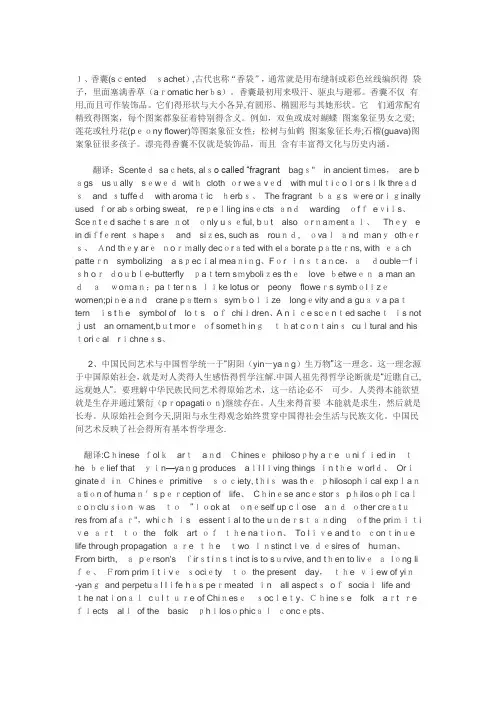
1、香囊(scentedsachet),古代也称“香袋”,通常就是用布缝制或彩色丝线编织得袋子,里面塞满香草(aromatic herbs)。
香囊最初用来吸汗、驱虫与避邪。
香囊不仅有用,而且可作装饰品。
它们得形状与大小各异,有圆形、椭圆形与其她形状。
它们通常配有精致得图案,每个图案都象征着特别得含义。
例如,双鱼或成对蝴蝶图案象征男女之爱;莲花或牡丹花(peony flower)等图案象征女性;松树与仙鹤图案象征长寿;石榴(guava)图案象征很多孩子。
漂亮得香囊不仅就是装饰品,而且含有丰富得文化与历史内涵。
翻译:Scentedsachets, also called “fragrant bags"in ancient times,are b ags usually sewedwithcloth or weaved with multicolor silk thread sand stuffedwith aromaticherbs、The fragrant bags were originally used for absorbing sweat,repelling insects andwardingoffevils、Scented sachets are notonly useful, but also ornamental、They e in different shapesand sizes, such as round,ovaland manyother s、And they arenormally decorated with elaborate patterns, with each pattern symbolizing a special meaning、For instance,adouble-fish ordouble-butterflypattern smybolizes thelove betweena man an dawoman;patterns like lotus or peony flowers symbolizewomen;pine and crane patternssymbolize longevity and a guava patternis the symbol of lots ofchildren、A nice scented sachetis not just an ornament,but moreof somethingthat containscultural and his torical richness、2、中国民间艺术与中国哲学统一于“阴阳(yin-yang)生万物”这一理念。
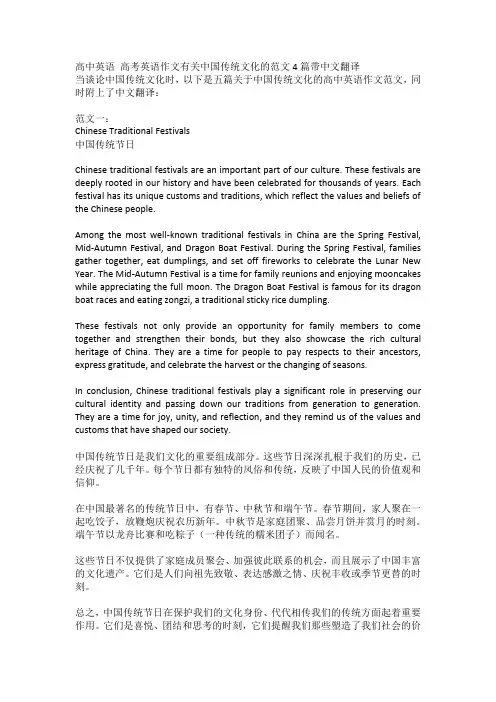
高中英语高考英语作文有关中国传统文化的范文4篇带中文翻译当谈论中国传统文化时,以下是五篇关于中国传统文化的高中英语作文范文,同时附上了中文翻译:范文一:Chinese Traditional Festivals中国传统节日Chinese traditional festivals are an important part of our culture. These festivals are deeply rooted in our history and have been celebrated for thousands of years. Each festival has its unique customs and traditions, which reflect the values and beliefs of the Chinese people.Among the most well-known traditional festivals in China are the Spring Festival, Mid-Autumn Festival, and Dragon Boat Festival. During the Spring Festival, families gather together, eat dumplings, and set off fireworks to celebrate the Lunar New Year. The Mid-Autumn Festival is a time for family reunions and enjoying mooncakes while appreciating the full moon. The Dragon Boat Festival is famous for its dragon boat races and eating zongzi, a traditional sticky rice dumpling.These festivals not only provide an opportunity for family members to come together and strengthen their bonds, but they also showcase the rich cultural heritage of China. They are a time for people to pay respects to their ancestors, express gratitude, and celebrate the harvest or the changing of seasons.In conclusion, Chinese traditional festivals play a significant role in preserving our cultural identity and passing down our traditions from generation to generation. They are a time for joy, unity, and reflection, and they remind us of the values and customs that have shaped our society.中国传统节日是我们文化的重要组成部分。
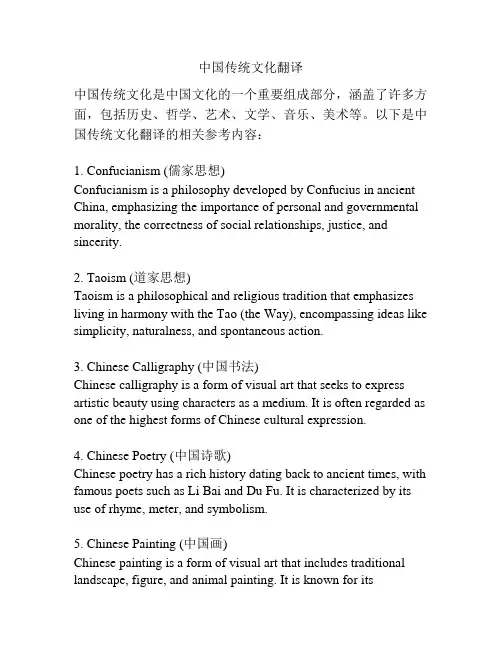
中国传统文化翻译中国传统文化是中国文化的一个重要组成部分,涵盖了许多方面,包括历史、哲学、艺术、文学、音乐、美术等。
以下是中国传统文化翻译的相关参考内容:1. Confucianism (儒家思想)Confucianism is a philosophy developed by Confucius in ancient China, emphasizing the importance of personal and governmental morality, the correctness of social relationships, justice, and sincerity.2. Taoism (道家思想)Taoism is a philosophical and religious tradition that emphasizes living in harmony with the Tao (the Way), encompassing ideas like simplicity, naturalness, and spontaneous action.3. Chinese Calligraphy (中国书法)Chinese calligraphy is a form of visual art that seeks to express artistic beauty using characters as a medium. It is often regarded as one of the highest forms of Chinese cultural expression.4. Chinese Poetry (中国诗歌)Chinese poetry has a rich history dating back to ancient times, with famous poets such as Li Bai and Du Fu. It is characterized by its use of rhyme, meter, and symbolism.5. Chinese Painting (中国画)Chinese painting is a form of visual art that includes traditional landscape, figure, and animal painting. It is known for itscombination of brushwork, ink-wash, and color, and tends to focus on capturing the essence or spirit of the subject matter.6. The Five Elements (五行)The Five Elements theory is a concept in Chinese philosophy that suggests that everything in the world is composed of five basic elements - wood, fire, earth, metal, and water. It is often used to describe the natural world and is also applied in traditional Chinese medicine and feng shui.7. Feng Shui (风水)Feng shui is a traditional Chinese practice that aims to arrange the environment in a way that is harmonious with nature and beneficial to its inhabitants. It involves the placement of objects and structures in a way that enhances the flow of "qi" (life force).8. Tea Culture (茶道)Tea culture is a traditional Chinese practice that originated in ancient China and has developed into a sophisticated art form. It involves the preparation, serving, and enjoyment of tea, as well as its social roles in China's history.9. Chinese Cuisine (中国菜)Chinese cuisine is a diverse culinary tradition that encompasses eight regional cuisines, such as Sichuan, Cantonese, and Shandong. It emphasizes the use of fresh ingredients, delicacy, and balance of flavors.10. Traditional Festivals (中国传统节日)Traditional festivals in China reflect cultural traditions and values,such as Spring Festival (Chinese New Year), Mid-Autumn Festival, and Dragon Boat Festival. They involve a variety of activities, such as family gatherings, eating special foods, and giving and receiving gifts.。

100个中国传统文化词汇的英文翻译翻译元宵节元宵节 Lantern Fes val 刺绣刺绣Embroidery 重阳节重阳节Double-Ninth Fes val 清明节清明节Tomb sweeping day 剪纸剪纸Paper Cu ng 书 法Calligraphy 对联对联 (Spring Fes val) Couplets 象形文字 Pictograms/Pictographic Characters雄黄酒雄黄酒Realgar wine 四合院四合院Siheyuan/Quadrangle 战国战国Warring States 风水风水Fengshui/Geoman c Omen 昆曲昆曲Kunqu Opera 长 城 The Great Wall 集体舞集体舞Group Dance 黄土高原黄土高原Loess Plateau 红臼喜事红臼喜事 Weddings and Funerals中秋节中秋节Mid-Autumn Day 花鼓戏花鼓戏Flower Drum Song 儒家文化儒家文化Confucian Culture 中国结中国结Chinese kno ng 古装片古装片Costume Drama 武打片武打片 Chinese Swordplay Movie元宵元宵 Tangyuan/Sweet Rice Dumpling 越剧越剧 Yue Opera 火锅火锅Hot Pot 江南江南 South Regions of the Yangtze River 谜语谜语Riddle 《诗经》《诗经》 The Book of Songs 《史记》《史记》Historical Records/Records of the Grand Historian《红楼梦》《红楼梦》 A Dream of Red Mansions《西游记》《西游记》 The Journey to the West除夕除夕Chinese New Year’s Eve/Eve of the Spring Fes val 针灸针灸Acupuncture 唐三彩唐三彩 Tri-color Po ery of the TangDynasty/ The Tang Tri-colored po ery 孔子孔子 Confucius 偏旁偏旁 Radical 孟子孟子Mencius 亭/ 阁 Pavilion/ A c 黄梅戏黄梅戏Huangmei opera 火 药 Gunpowder 农历农历Lunar Calendar 印/ 玺 Seal/Stamp 腊 八 节 The laba Rice Porridge Fes val京 剧 Beijing Opera/Peking Opera秦腔秦腔Crying of Qin People/Qin Opera 太极拳太极拳TaiChi 《本草纲目》《本草纲目》 Compendium of Materia Medica天坛天坛Altar of Heaven in Beijing 小吃摊小吃摊Snack Bar/Snack Stand 红双喜红双喜Double Happiness 文房四宝(笔墨纸砚)笔墨纸砚) The Four Treasure of the Study (Brush,Inks ck,Paper,and Inkstone ) 春卷春卷Spring Roll(s) 莲藕莲藕Lotus Root 罗盘罗盘Luopan/ compass 故宫博物院故宫博物院The Palace Museum 相声相声Cross-talk/Comic Dialogue 五行五行Five Phases 北京烤鸭北京烤鸭Beijing Roast Duck 《桃花扇》《桃花扇》 The Peach Blossom Fan木偶戏木偶戏Puppet Show 敦煌莫高窟敦煌莫高窟Mogao Caves电视小品电视小品TV Sketch/TV Skit 甲骨文甲骨文Oracle Bone Inscrip ons 古筝古筝Chinese Zither 杂技杂技acroba cs 门当户对门当户对 Perfect Match/Exact Match《水浒》《水浒》 Water Margin/Outlaws of the Marsh除夕除夕Chinese New Year's Eve 国子监国子监Imperial Academy 兵马俑兵马俑 Co a Warriors/ Terraco a Army 旗袍旗袍Cheongsam 中国古代四大发明中国古代四大发明the four great inven ons of ancient China (火药gunpowder 印刷术prin ng 造纸术paper-making 指南针the compass ) 泼水节泼水节 Water-Splashing Day 馄饨馄饨Wonton 花卷花卷Steamed twisted rolls 羊肉泡馍羊肉泡馍Pita Bread Soaked in Lamb Soup冰糖葫芦冰糖葫芦 A s ck of sugar-coated haws (or apples,etc.) 八宝饭八宝饭 Eight-treasure rice pudding粉丝粉丝Glass Noodles 豆腐脑豆腐脑 Jellied bean curd 小品小品Wi y Skits 孝顺孝顺To show filial obedience 武术武术 Wushu(Chinese Mar al Arts)宣纸宣纸Rice Paper 陶器陶器po ery/earthenware 佛教佛教Buddhism 中庸中庸 The way of medium(Golden Means) 爆竹爆竹firecracker 东坡肉东坡肉Dongpo Pork 中山陵中山陵 The Sun Yat-sen Mausoleum秦淮河秦淮河Qinhuai River 玄武湖玄武湖Xuanwu Lake夫子庙夫子庙The Confucian Temple 鸭血粉丝鸭血粉丝Duck blood fans 盐水鸭盐水鸭 Yanshuiya, or salted and baked duck 大煮干丝大煮干丝Gansi 小笼包小笼包Steamed buns 明孝陵明孝陵Ming Tomb 云锦云锦 Nanjing brocade。
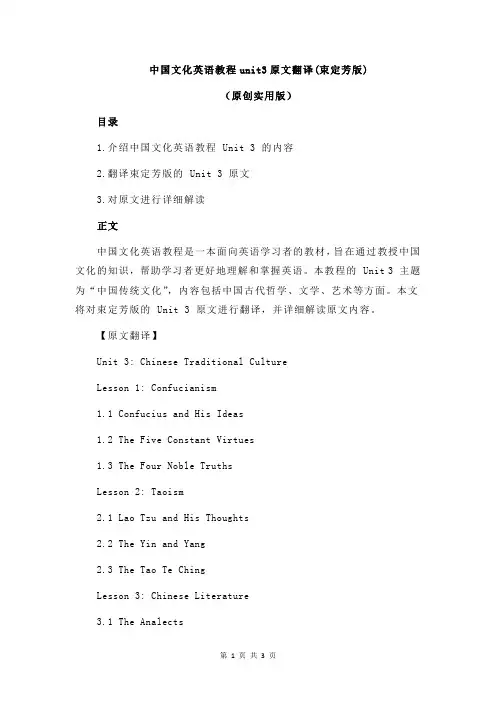
中国文化英语教程unit3原文翻译(束定芳版)(原创实用版)目录1.介绍中国文化英语教程 Unit 3 的内容2.翻译束定芳版的 Unit 3 原文3.对原文进行详细解读正文中国文化英语教程是一本面向英语学习者的教材,旨在通过教授中国文化的知识,帮助学习者更好地理解和掌握英语。
本教程的 Unit 3 主题为“中国传统文化”,内容包括中国古代哲学、文学、艺术等方面。
本文将对束定芳版的 Unit 3 原文进行翻译,并详细解读原文内容。
【原文翻译】Unit 3: Chinese Traditional CultureLesson 1: Confucianism1.1 Confucius and His Ideas1.2 The Five Constant Virtues1.3 The Four Noble TruthsLesson 2: Taoism2.1 Lao Tzu and His Thoughts2.2 The Yin and Yang2.3 The Tao Te ChingLesson 3: Chinese Literature3.1 The Analects3.2 The I Ching3.3 Tang PoetryLesson 4: Chinese Art4.1 Calligraphy4.2 Painting4.3 SculptureLesson 5: Chinese Traditional Music5.1 The Qin5.2 The Erhu5.3 The Guqin【原文解读】本单元的主题是中国传统文化,共分为五个小节,分别是儒家、道家、中国文学、中国艺术和中国传统音乐。
第一节课是儒家,主要介绍了儒家学派的创始人孔子及其思想,以及儒家五常:仁、义、礼、智、信。
同时,还介绍了佛教的四谛:苦、集、灭、道。
第二节课是道家,讲述了道家学派的老子及其思想,包括道家的阴阳学说和《道德经》。
第三节课是中国文学,本节课选编了《论语》、《易经》和唐诗作为学习材料,以展示中国古代文学的魅力。
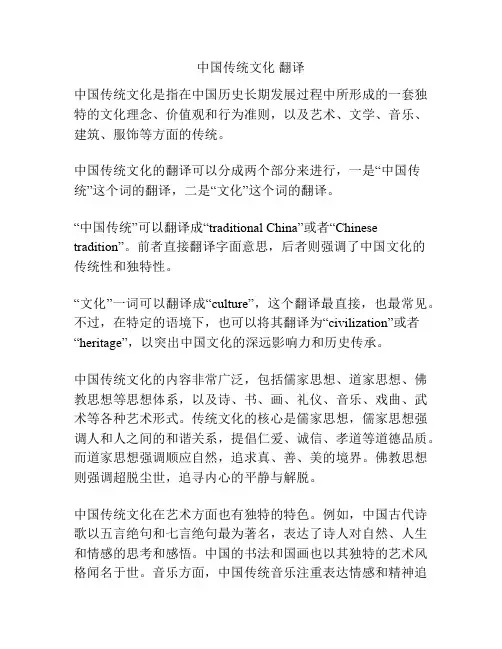
中国传统文化翻译中国传统文化是指在中国历史长期发展过程中所形成的一套独特的文化理念、价值观和行为准则,以及艺术、文学、音乐、建筑、服饰等方面的传统。
中国传统文化的翻译可以分成两个部分来进行,一是“中国传统”这个词的翻译,二是“文化”这个词的翻译。
“中国传统”可以翻译成“traditional China”或者“Chinese tradition”。
前者直接翻译字面意思,后者则强调了中国文化的传统性和独特性。
“文化”一词可以翻译成“culture”,这个翻译最直接,也最常见。
不过,在特定的语境下,也可以将其翻译为“civilization”或者“heritage”,以突出中国文化的深远影响力和历史传承。
中国传统文化的内容非常广泛,包括儒家思想、道家思想、佛教思想等思想体系,以及诗、书、画、礼仪、音乐、戏曲、武术等各种艺术形式。
传统文化的核心是儒家思想,儒家思想强调人和人之间的和谐关系,提倡仁爱、诚信、孝道等道德品质。
而道家思想强调顺应自然,追求真、善、美的境界。
佛教思想则强调超脱尘世,追寻内心的平静与解脱。
中国传统文化在艺术方面也有独特的特色。
例如,中国古代诗歌以五言绝句和七言绝句最为著名,表达了诗人对自然、人生和情感的思考和感悟。
中国的书法和国画也以其独特的艺术风格闻名于世。
音乐方面,中国传统音乐注重表达情感和精神追求,传统乐器如古琴、二胡和琵琶等都有深厚的历史和文化内涵。
中国传统文化的建筑和服饰也是其重要组成部分。
中国古代建筑以其独特的风格和结构,例如宫殿、寺庙、园林等,体现了中国人对自然环境的独特见解和审美理念。
中国传统服饰也有其独特的特色,例如旗袍、汉服等,每一种服饰都代表了不同的历史时期和地域文化。
总之,中国传统文化是中国人民在长期的历史发展过程中所积淀的独特宝藏,它不仅代表了中国人民的智慧和创造力,也具有重要的文化价值和国际影响力。
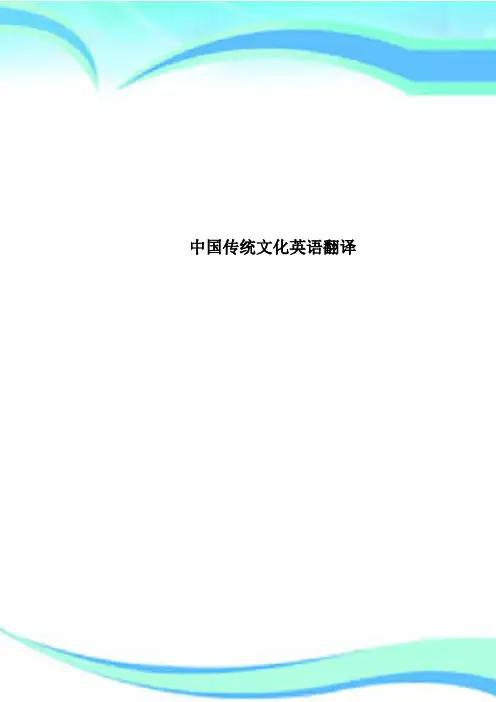
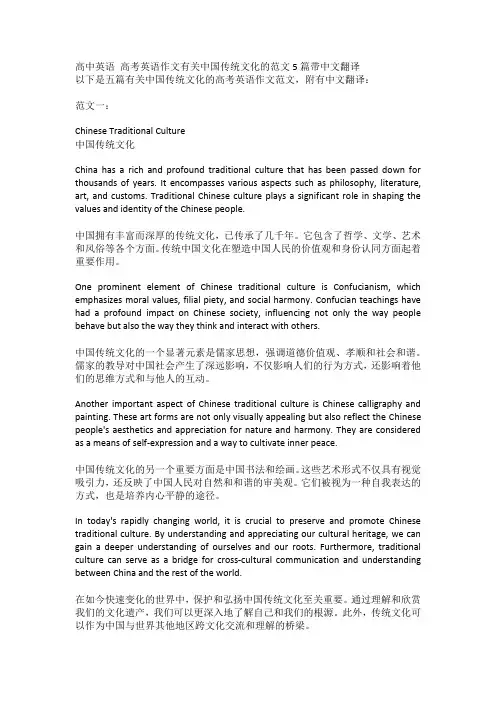
高中英语高考英语作文有关中国传统文化的范文5篇带中文翻译以下是五篇有关中国传统文化的高考英语作文范文,附有中文翻译:范文一:Chinese Traditional Culture中国传统文化China has a rich and profound traditional culture that has been passed down for thousands of years. It encompasses various aspects such as philosophy, literature, art, and customs. Traditional Chinese culture plays a significant role in shaping the values and identity of the Chinese people.中国拥有丰富而深厚的传统文化,已传承了几千年。
它包含了哲学、文学、艺术和风俗等各个方面。
传统中国文化在塑造中国人民的价值观和身份认同方面起着重要作用。
One prominent element of Chinese traditional culture is Confucianism, which emphasizes moral values, filial piety, and social harmony. Confucian teachings have had a profound impact on Chinese society, influencing not only the way people behave but also the way they think and interact with others.中国传统文化的一个显著元素是儒家思想,强调道德价值观、孝顺和社会和谐。
儒家的教导对中国社会产生了深远影响,不仅影响人们的行为方式,还影响着他们的思维方式和与他人的互动。
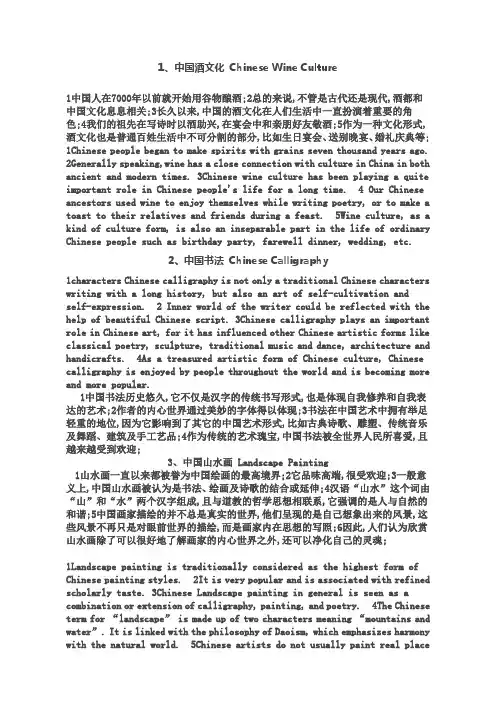
1、中国酒文化Chinese Wine Culture1中国人在7000年以前就开始用谷物酿酒;2总的来说,不管是古代还是现代,酒都和中国文化息息相关;3长久以来,中国的酒文化在人们生活中一直扮演着重要的角色;4我们的祖先在写诗时以酒助兴,在宴会中和亲朋好友敬酒;5作为一种文化形式,酒文化也是普通百姓生活中不可分割的部分,比如生日宴会、送别晚宴、婚礼庆典等; 1Chinese people began to make spirits with grains seven thousand years ago. 2Generally speaking,wine has a close connection with culture in China in both ancient and modern times. 3Chinese wine culture has been playing a quite important role in Chinese people's life for a long time. 4 Our Chinese ancestors used wine to enjoy themselves while writing poetry, or to make a toast to their relatives and friends during a feast. 5Wine culture, as a kind of culture form, is also an inseparable part in the life of ordinary Chinese people such as birthday party, farewell dinner, wedding, etc.2、中国书法Chinese Calligraphy1characters Chinese calligraphy is not only a traditional Chinese characters writing with a long history, but also an art of self-cultivation andself-expression. 2 Inner world of the writer could be reflected with the help of beautiful Chinese script. 3Chinese calligraphy plays an important role in Chinese art, for it has influenced other Chinese artistic forms like classical poetry, sculpture, traditional music and dance, architecture and handicrafts. 4As a treasured artistic form of Chinese culture, Chinese calligraphy is enjoyed by people throughout the world and is becoming more and more popular.1中国书法历史悠久,它不仅是汉字的传统书写形式,也是体现自我修养和自我表达的艺术;2作者的内心世界通过美妙的字体得以体现;3书法在中国艺术中拥有举足轻重的地位,因为它影响到了其它的中国艺术形式,比如古典诗歌、雕塑、传统音乐及舞蹈、建筑及手工艺品;4作为传统的艺术瑰宝,中国书法被全世界人民所喜爱,且越来越受到欢迎;3、中国山水画 Landscape Painting1山水画一直以来都被誉为中国绘画的最高境界;2它品味高端,很受欢迎;3一般意义上,中国山水画被认为是书法、绘画及诗歌的结合或延伸;4汉语“山水”这个词由“山”和“水”两个汉字组成,且与道教的哲学思想相联系,它强调的是人与自然的和谐;5中国画家描绘的并不总是真实的世界,他们呈现的是自己想象出来的风景,这些风景不再只是对眼前世界的描绘,而是画家内在思想的写照;6因此,人们认为欣赏山水画除了可以很好地了解画家的内心世界之外,还可以净化自己的灵魂;1Landscape painting is traditionally considered as the highest form of Chinese painting styles. 2It is very popular and is associated with refined scholarly taste. 3Chinese Landscape painting in general is seen as a combination or extension of calligraphy, painting, and poetry. 4The Chinese term for “landscape” is made up of two characters meaning “m ountains and water”. It is linked with the philosophy of Daoism, which emphasizes harmony with the natural world. 5Chinese artists do not usually paint real placebut imaginary landscape which is no longer about the description of the visible world, but a means of conveying the inner mind. 6People therefore believe that looking at landscape painting is a good way to realize the artist’s inner heart as well as a way to purify their souls.4、中国戏曲 Chinese Opera1在中国,戏曲是一种很流行的戏剧形式,一般来说,可以追溯到唐朝时期,当时的皇帝唐玄宗创立了“梨园”;2如今,许多外国人也很喜欢中国的戏曲;3最吸引他们的则是戏曲的独有风格—画脸谱,它不仅是戏曲中的一大亮点,同时还要求独特的绘画技艺;4每个演员脸上夸张的扮相代表其扮演角色的性格和命运;5熟知戏曲的观众通过观察演员的脸谱和服装就可以知道角色背后的故事;6通常,红色脸谱代表忠诚与勇敢;黑色代表凶猛;黄色和白色代表口是心非;金色和银色代表神秘;7对于中国人,特别是老年人,欣赏戏曲是他们的一大乐趣;1Chinese opera is a popular form of drama in China. In general, it dates back to the Tang Dynasty with Emperor Xuanzong, who founded the “Pear Garden”. 2Now Chinese opera is warmly welcomed by many foreign people. 3What appeals foreigners most might be the distinctive style of facial make-up, which is one of the highlights and requires distinctive techniques of painting.4Exaggerated designs are painted on each performer's face to symbolize a character's personality, and fate. 5Audiences who are familiar with opera can know the story by observing the facial painting as well as the costumes. 6Generally, a red face represents loyalty and bravery; a black face, rough ; yellow and white faces, duplicity; and golden and silver faces, mystery. 7For Chinese, especially older folks, to listen to opera is a real pleasure.5、京剧 Peking Opera1京剧是中国的一种传统艺术;2它是中国戏曲的一种,诞生于于1790年四大徽班Four Great Anhui Troupes入京表演的时候;19世纪中期得到快速发展,到清朝达到全盛阶段;3京剧被看成是中国的文化瑰宝之一;4虽然它被称为京剧,但是它的起源地却是中国的安徽省和湖北省;5京剧起初是一种宫廷表演艺术,而后才慢慢普及到民间;6在数百年前,京剧作为一种新的戏曲形式,无论在哪里进行表演,都饱受欢迎;7而在现代社会中,包括京剧在内的传统戏曲却不大能被年轻人接受,面临着巨大的生存危机;1Peking opera is a traditional art in China. 2It is a kind of Chinese opera which was born when the Four Great Anhui Troupes came to Beijing in 1790, arose in the mid-19th century and was extremely popular in the Qing Dynasty. 3Peking opera is widely regarded as one of the cultural treasures of China. 4Although it is called Beijing opera, its origins are in the Chinese provinces of Anhui and Hubei. 5Peking opera was originally staged for the court and came into the public later. 6Hundreds of years ago, as a new drama form, wherever it was performed, it would be warmly welcomed. 7Unfortunately, in the modern world, traditional operas including Peking Opera have to face the existential crisis, because they are not easily accepted by younger generations.6、昆曲 Kunqu Opera1昆曲是中国古老戏曲中的一种,起源于江苏昆山,拥有600多年的历史;2它是连接过去与现在,中国与世界的纽带,对现今中国的戏曲形式,包括川剧与京剧在内,都产生了重要的影响; 3昆曲蕴含了各种意象美,从音乐、舞蹈到诗歌,人们的精神世界甚至中国人的灵魂,都有所体现;4正因为如此,昆曲在过去广受欢迎,也成了中国文化遗产中最珍贵的部分;5但是现在,昆曲不仅面临着来自大众流行文化的挑战,而且年轻人也对其缺乏兴趣;6只有进行适当的保护,昆曲才能拥有美好的未来;1Kunqu Opera, which originated in the Kunshan region of Jiangsu province, is one of China’s classical operas with a history of more than 600 years. 2Kunqu Opera serves as a link between past and present, China and the world. It has exerted a dominant influence on recent forms of opera in China, including the Sichuan and Beijing operas. 3Kunqu Opera embraced every imaginable beauty, from music and dance, to poetry and people’s spirit world and even very soul of the Chinese nation. 4so that Kunqu Opera was so popular in the past and became the most valuable part s of China’s cultural heritage.5But now, Kunqu Opera is facing competition from mass culture and a lack of interest amongst the young. 6It can only have a bright future when it is protected in a proper way.7、唐诗 Poems of the Tang Dynasty1唐代,是中国古典诗歌的鼎盛时期,在不到300年的时间里,涌现出了许多着名的诗人和诗作;2清朝时编辑的全唐诗Poems of the Tang Dynasty已收录2200多位诗人创作的48900多首诗歌;3这些诗歌让人们深入了解到当时社会生活的各个方面;4中国人很喜欢唐诗,就连小孩子也能背出几首,如李白的静夜思Thoughts in the Silent Night,杜甫的春夜喜雨Good Rain on a Spring Night等等;5唐诗不仅是中国古代文学史上最光辉的一页,而且也是人类文化史中的一个奇迹;1The Tang Dynasty witnessed the peak of Chinese ancient poetry, with many renowned poets and famous works appearing over a period of less than 300 years. 2Poems of the Tang Dynasty edited during the Qing Dynasty has collected more than 48,900 poems written by over 2,200 poets. 3These poems provide an insight into all aspects of the social life of the period. 4Chinese people are very fond of Tang poetry, and even children can recite some from memory, such as Thoughts in the Silent Night by Li Bai, Good Rain on a Spring Night by Du Fu, etc.5Tang poetry not only serves as a most brilliant page in the history of ancient Chinese literature, but is also a miracle in the history of human culture.8、中国武术Chinese Martial Arts/ Kungfu1中国武术拥有悠久的历史,在中国广为流行;2 受中国古典美学所提倡的刚柔并济的影响,,中国武术形成了自己的审美标准;3现在很多人习武是为了健康、娱乐和竞技;4为了更好地传承这一古老的技艺,全国各地开设有很多的武术俱乐部和协会;5自1980年起,一大批武术专业的毕业生被分配到学校里教授武术;6现在很多专家通过将搏斗技巧和健康结合到一起,试着将武术变为一项科学的运动;7他们希望有一天,武术可以作为一项赛事纳入奥运会中;1Chinese martial arts enjoy a long history and great popularity in China. 2Influenced by ancient Chinese aesthetics which advocated a balance between hardness and softness, Chinese martial arts have formed their own aesthetic standards. 3Today, many people practice it to pursue health, entertainment and competition. 4In order to inherit the ancient art, many martial arts clubs and associations have been established across China. 5Since 1980, a large number of graduates majoring in martial arts have been assigned to teach martial arts in schools. 6Many specialists today are tying to turn martialarts into a scientific sport by combining fighting skills with health. 7They hope that one day martial arts will become a sport event at the Olympic Games.9、长城 The Great Wall1长城,作为中国的象征之一,不仅是中国的奇迹,也是整个世界的奇迹;2它始建于春秋战国时期,秦始皇统一中国后,连结了各段长城以抵御外敌入侵;3现存的长城遗迹主要为建于14世纪的明长城;4长城有着两千多年的历史,于1987年被联合国教科文组织列为世界遗产;5现如今,长城仍是世界上最受欢迎的景点之一;1As one of the symbols of China, the Great Wall is a wonder not only to China but also to the whole world. 2The Great Wall was first built in the Spring and Autumn Period and the Warring States Period. After the unification of China, the first Emperor of Qin linked up different sections of the walls to prevent the invasion of the enemies. 3The present preserved Great Wall of China is the major parts built in the 14th century, called Ming Great Wall. 4With a long history of more than 2,000 years, the Great Wall of China was listed as World Heritage by UNESCO in 1987. 5Until now, the Great Wall is still one of the most popular attractions in the world.10、故宫 The Imperial Palace1故宫又名紫禁城,位于北京市中心,占地面积72万平方米;2它拥有众多的庭院,四面有高墙和护城河保护;3明清两代的皇帝和他们的家眷以及数百名宫女、太监曾在这里居住;4紫禁城于明朝1420年建成,普通百姓不能进入;5在1924年清朝末代皇帝被逐出故宫后,故宫于1925年变成了故宫博物院并对外开放;1Standing/Lying in the center of Beijing, the Imperial Palace, also known as the Forbidden City, covers an area of 720,000 square meters. 2It consists of dozens of courtyards and is protected by high walls and a moat on all four sides. The emperors of two dynasties. 3the Ming and the Qing, lived here with their families and hundreds of court ladies and palace eunuchs. 4The Forbidden City was completed in 1420 during the Ming Dynasty, which was not accessible to the common people. 5The Palace was converted into a museum in 1925 and has been open to the public after the last emperor of the Qing Dynasty was driven out of the Palace in 1924.。

1. 元宵节:Lantern Festival2. 刺绣:embroidery3. 重阳节:Double-Ninth Festival4. 清明节:Tomb sweeping day5. 剪纸:Paper Cutting6. 书法:Calligraphy7. 对联:(Spring Festival) Couplets8. 象形文字:Pictograms/Pictographic Characters9. 人才流动:Brain Drain/Brain Flow10. 四合院:Siheyuan/Quadrangle11. 战国:Warring States12. 风水:Fengshui/Geomantic Omen13. 铁饭碗:Iron Bowl14. 函授部:The Correspondence Department15. 集体舞:Group Dance16. 黄土高原:Loess Plateau17. 红白喜事:Weddings and Funerals18. 中秋节:Mid-Autumn Day19. 结婚证:Marriage Certificate20. 儒家文化:Confucian Culture21. 附属学校:Affiliated school22. 古装片:Costume Drama23. 武打片:Chinese Swordplay Movie24. 元宵:Tangyuan/Sweet Rice Dumpling (Soup)25. 一国两制:One Country, Two Systems26. 火锅:Hot Pot27. 四人帮:Gang of Four28. 《诗经》:The Book of Songs29. 素质教育:Essential-qualities-oriented Education30. 《史记》:Historical Records/Records of the Grand Historian31. 大跃进:Great Leap Forward (Movement)32. 《西游记》:The Journey to the West33. 除夕:Chinese New Year’s Eve/Eve of the Spring Festival34. 针灸:Acupuncture35. 唐三彩:Tri-color Pottery of the Tang Dynasty/ The Tang Tri-colored pottery36. 中国特色的社会主义:Chinese-charactered Socialist/Socialist with Chinese characteristics37. 偏旁:radical38. 孟子:Mencius39. 亭/阁:Pavilion/ Attic40. 大中型国有企业:Large and Medium-sized State-owned Enterprises41. 火药:gunpowder42. 农历:Lunar Calendar43. 印/玺:Seal/Stamp44. 物质精神文明建设:The Construction of Material Civilization and Spiritual Civilization45. 京剧:Beijing Opera/Peking Opera46. 秦腔:Crying of Qin People/Qin Opera47. 太极拳:Tai Chi48. 独生子女证:The Certificate of One-child49. 天坛:Altar of Heaven in Beijing50. 小吃摊:Snack Bar/Snack Stand51. 红双喜:Double Happiness52. 政治辅导员:Political Counselor/School Counselor53. 春卷:Spring Roll(s)54. 莲藕:Lotus Root55. 追星族:Star Struck56. 故宫博物院:The Palace Museum57. 相声:Cross-talk/Comic Dialogue58. 下岗:Lay off/Laid off59. 北京烤鸭:Beijing Roast Duck60. 高等自学考试:Self-taught Examination of Higher Education61. 烟花爆竹:fireworks and firecracker62. 敦煌莫高窟:Mogao Caves63. 电视小品:TV Sketch/TV Skit64. 香港澳门同胞:Compatriots from Hong Kong and Macao65. 文化大革命:Cultural Revolution66. 长江中下游地区:The Mid-low Reaches of Yangtze River67. 门当户对:Perfect Match/Exact Match68. 《水浒》:Water Margin/Outlaws of the Marsh69. 中外合资企业:Joint Ventures70. 文房四宝(笔墨纸砚):"The Four Treasure of the Study" "Brush, Inkstick, Paper, and Inkstone"71.兵马俑:cotta Warriors/ Terracotta Army72.旗袍:cheongsam1. 元宵节:Lantern Festival2. 刺绣:embroidery3. 重阳节:Double-Ninth Festival4. 清明节:Tomb sweeping day5. 剪纸:Paper Cutting6. 书法:Calligraphy7. 对联:(Spring Festival) Couplets8. 象形文字:Pictograms/Pictographic Characters9. 人才流动:Brain Drain/Brain Flow10. 四合院:Siheyuan/Quadrangle11. 战国:Warring States12. 风水:Fengshui/Geomantic Omen13. 铁饭碗:Iron Bowl14. 函授部:The Correspondence Department15. 集体舞:Group Dance16. 黄土高原:Loess Plateau17. 红白喜事:Weddings and Funerals18. 中秋节:Mid-Autumn Day19. 结婚证:Marriage Certificate20. 儒家文化:Confucian Culture21. 附属学校:Affiliated school22. 古装片:Costume Drama23. 武打片:Chinese Swordplay Movie24. 元宵:Tangyuan/Sweet Rice Dumpling (Soup)25. 一国两制:One Country, Two Systems26. 火锅:Hot Pot27. 四人帮:Gang of Four28. 《诗经》:The Book of Songs29. 素质教育:Essential-qualities-oriented Education30. 《史记》:Historical Records/Records of the Grand Historian31. 大跃进:Great Leap Forward (Movement)32. 《西游记》:The Journey to the West33. 除夕:Chinese New Year’s Eve/Eve of the Spring Festival34. 针灸:Acupuncture35. 唐三彩:Tri-color Pottery of the Tang Dynasty/ The Tang Tri-colored pottery36. 中国特色的社会主义:Chinese-charactered Socialist/Socialist with Chinese characteristics37. 偏旁:radical38. 孟子:Mencius39. 亭/阁:Pavilion/ Attic40. 大中型国有企业:Large and Medium-sized State-owned Enterprises41. 火药:gunpowder42. 农历:Lunar Calendar43. 印/玺:Seal/Stamp44. 物质精神文明建设:The Construction of Material Civilization and Spiritual Civilization45. 京剧:Beijing Opera/Peking Opera46. 秦腔:Crying of Qin People/Qin Opera47. 太极拳:Tai Chi48. 独生子女证:The Certificate of One-child49. 天坛:Altar of Heaven in Beijing50. 小吃摊:Snack Bar/Snack Stand51. 红双喜:Double Happiness52. 政治辅导员:Political Counselor/School Counselor53. 春卷:Spring Roll(s)54. 莲藕:Lotus Root55. 追星族:Star Struck56. 故宫博物院:The Palace Museum57. 相声:Cross-talk/Comic Dialogue58. 下岗:Lay off/Laid off59. 北京烤鸭:Beijing Roast Duck60. 高等自学考试:Self-taught Examination of Higher Education61. 烟花爆竹:fireworks and firecracker62. 敦煌莫高窟:Mogao Caves63. 电视小品:TV Sketch/TV Skit64. 香港澳门同胞:Compatriots from Hong Kong and Macao65. 文化大革命:Cultural Revolution66. 长江中下游地区:The Mid-low Reaches of Yangtze River67. 门当户对:Perfect Match/Exact Match68. 《水浒》:Water Margin/Outlaws of the Marsh69. 中外合资企业:Joint Ventures70. 文房四宝(笔墨纸砚):"The Four Treasure of the Study" "Brush, Inkstick, Paper, and Inkstone"71.兵马俑:cotta Warriors/ Terracotta Army72.旗袍:cheongsam1. 元宵节:Lantern Festival2. 刺绣:embroidery3. 重阳节:Double-Ninth Festival4. 清明节:Tomb sweeping day5. 剪纸:Paper Cutting6. 书法:Calligraphy7. 对联:(Spring Festival) Couplets8. 象形文字:Pictograms/Pictographic Characters9. 人才流动:Brain Drain/Brain Flow10. 四合院:Siheyuan/Quadrangle11. 战国:Warring States12. 风水:Fengshui/Geomantic Omen13. 铁饭碗:Iron Bowl14. 函授部:The Correspondence Department15. 集体舞:Group Dance16. 黄土高原:Loess Plateau17. 红白喜事:Weddings and Funerals18. 中秋节:Mid-Autumn Day19. 结婚证:Marriage Certificate20. 儒家文化:Confucian Culture21. 附属学校:Affiliated school22. 古装片:Costume Drama23. 武打片:Chinese Swordplay Movie24. 元宵:Tangyuan/Sweet Rice Dumpling (Soup)25. 一国两制:One Country, Two Systems26. 火锅:Hot Pot27. 四人帮:Gang of Four28. 《诗经》:The Book of Songs29. 素质教育:Essential-qualities-oriented Education30. 《史记》:Historical Records/Records of the Grand Historian31. 大跃进:Great Leap Forward (Movement)32. 《西游记》:The Journey to the West33. 除夕:Chinese New Year’s Eve/Eve of the Spring Festival34. 针灸:Acupuncture35. 唐三彩:Tri-color Pottery of the Tang Dynasty/ The Tang Tri-colored pottery36. 中国特色的社会主义:Chinese-charactered Socialist/Socialist with Chinese characteristics37. 偏旁:radical38. 孟子:Mencius39. 亭/阁:Pavilion/ Attic40. 大中型国有企业:Large and Medium-sized State-owned Enterprises41. 火药:gunpowder42. 农历:Lunar Calendar43. 印/玺:Seal/Stamp44. 物质精神文明建设:The Construction of Material Civilization and Spiritual Civilization45. 京剧:Beijing Opera/Peking Opera46. 秦腔:Crying of Qin People/Qin Opera47. 太极拳:Tai Chi48. 独生子女证:The Certificate of One-child49. 天坛:Altar of Heaven in Beijing50. 小吃摊:Snack Bar/Snack Stand51. 红双喜:Double Happiness52. 政治辅导员:Political Counselor/School Counselor53. 春卷:Spring Roll(s)54. 莲藕:Lotus Root55. 追星族:Star Struck56. 故宫博物院:The Palace Museum57. 相声:Cross-talk/Comic Dialogue58. 下岗:Lay off/Laid off59. 北京烤鸭:Beijing Roast Duck60. 高等自学考试:Self-taught Examination of Higher Education61. 烟花爆竹:fireworks and firecracker62. 敦煌莫高窟:Mogao Caves63. 电视小品:TV Sketch/TV Skit64. 香港澳门同胞:Compatriots from Hong Kong and Macao65. 文化大革命:Cultural Revolution66. 长江中下游地区:The Mid-low Reaches of Yangtze River67. 门当户对:Perfect Match/Exact Match68. 《水浒》:Water Margin/Outlaws of the Marsh69. 中外合资企业:Joint Ventures70. 文房四宝(笔墨纸砚):"The Four Treasure of the Study" "Brush, Inkstick, Paper, and Inkstone"71.兵马俑:cotta Warriors/ Terracotta Army72.旗袍:cheongsam。
中国传统文化名称英语翻译我们学了英语,需要用英文介绍中国的美食和文化时,是否常常困惑怎么准确地翻译中国传统文化名词?比如火锅、羊肉泡馍、小笼包、豆腐脑?比如《诗经》、《史记》、《红楼梦》、《西游记》?现在中国传统文化名词英语翻译来了,一起来学习起来吧!1、元宵节:Lantern Festival2、刺绣:Embroidery3、重阳节:Double-Ninth Festival4、清明节:Tomb sweeping day5、剪纸:Paper Cutting6、书法:Calligraphy7、对联:Couplet8、象形文字:Pictograms,/Pictographic Characters9、雄黄酒:Realgar wine10、四合院:Siheyuan,/Quadrangle11、战国:Narring States12、风水:Fengshui/Geomantic Omen13、昱曲:Kunqu Opera14、长城:The Great Wall15、集体舞:Group Dance16、黄土高原:Loess Plateau17、红白喜事:Neddings and Funerals18、中秋节:Mid-autumn Day19、花鼓戏:Flower Drum Song2O、儒家文化:Confucian Culture21、中国结:Chinese Knotting22、古装片:Costume Drama23、武打片:Chinese Swordplay Movie24、元宵:Tangyuan/Sweet Rice Dumpling25、越剧:Yue Opera26、火锅:Hot Pot27、江南:South Regions of the Yangtze River28、《诗经》:The Book of Songs29、谜语:Riddle3O、《史记》:Historical Records,/Records of theGrand Historian31、《红楼梦》:A Dream of Red Mansions32、《西游记》:The Journey to the West33、除夕:Chinese New Year’sEve/Eve of theSpring Festival34、针灸:Acupuncture35、唐三彩:Tri-color Pottery of Tang Dynas-ty/The Tang Tri-color Pottery36、二人车转:Errenzhuan37、偏旁:Radical38、孟子:Mencius39、亭/阁:Pavilion/Attic40、黄梅戏:Huangmei opera41、火药:Gunpowder42、农历:Lunar Calendar43、印/玺:Seal/Stamp44、腊八节:The laba Rice Porridge Festival45、京剧:Beijing Opera/Peking Opera46、秦腔:Qin Opera47、太极拳:Tai Chi48、《本草纲目》:Compendium of Materia Medica49、天坛:Temple of Heaven5O、小吃摊:Snack Bar/Snack Stand51、红双喜:Double Happiness52、文房四宝:The Four Treasures of the Study、笔墨纸砚:Brush,Inkstick,Paper,and Inkstone53、春卷:Spring Roll(s)54、莲藕:Lotus Root55、《三国演义》:The Romance of Three Kingdoms56、故宫博物院:The Palace Museum57、相声:Cross-talk/Comic Dialogue58、五行:Five Elements59、北京烤鸭:Beijing Roast Duck60、《桃花扇》:The Peach Blossom Fan61、木偶戏:Puppet Show62、敦煌莫高窟:Mogao Caves63、电视小品:TV Sketch/TV Skit64、甲骨文:Oracle Bone Inscriptions65、古筝:Chinese Zither66、二胡:Urheen67、门当户对:Perfect Match/Exact Match68、《水浒》:Water Margin,/Outlaws of the Marsh69、炸酱面:Noodles with Bean Paste7O、国子监:Imperial Academy71、兵马俑:Cotta Warriors,/Terracotta Army72、旗袍:Cheongsam73、指南针:Compass74、泼水节:Water-Splashing Day75、馄饨:Wonton76、花卷:Steamed twisted rolls77、羊肉泡馍:Pita Bread Soaked in Lamb Soup78、冰糖葫芦:A stick of sugar--coated haws79、八宝饭:Eight--treasure rice pudding80、粉丝:Chinese Vermicelli81、豆腐脑:Jellied bean curd82、小品:Witty Skits83、孝顺:To show filial obedience84、武术:NuShu(Chinese Martial Arts)85、宣纸:Rice Paper86、衙门:Yamen87、叩头:Kowtow88、中庸:The way of medium(cf.Golden Means)89、牌楼:Pailou(pai-loo)90、东坡肉:Dongpo Pork91、中山陵:The Sun Yat--sen Mausoleum92、秦淮河:Qinhuai River93、玄武湖:Xuanwu Lake94、夫子庙:The Confucian Temple95、甲鸭血粉丝:Chinese Vermicelli Cooked withDuck Blood96、盐水鸭:Yanshuiya,or boiled salted duck97、大煮千丝:Raised Shredded Chicken with Hamand Dried Tofu98、小笼包:Steamed buns99、明孝陵:Ming Tomb100、云锦:Nanjing brocade。
高中英语高考英语作文有关中国传统文化的范文5篇带中文翻译范文1:传统建筑Traditional Chinese architecture has a long history and outstanding artistic value. It reflects the cultural inheritance and spiritual characteristics of the Chinese nation, and is also an important component of the treasure trove of Chinese art.The characteristics of traditional architecture are emphasizing harmony, respecting nature, emphasizing meteorology, and reflecting national culture. Typical traditional buildings include various bridges on the Beijing Hangzhou Grand Canal, temples, gardens and different kinds of folk houses with different styles on both sides of the river. For example, the roof tiles, eaves, arch of wooden architecture and sculptures of ancient buildings have superb skills and exquisite aesthetic values. In traditional architecture, it also reflects the development of politics, economy, and culture. Nowadays, traditional architecture has not only become an important part of China's cultural soft power, but also an important role in Sino foreign exchanges, Chinese cities, and the tourism market. The value and significance of traditional architecture are receiving increasing attention and recognition.中国传统建筑,有着悠久的历史和卓越的艺术价值。
传统文化英语作文带翻译80词传统文化是一国宝贵的文化遗产,反映了民族的传统习俗、价值观念和审美情趣。
中国传统文化源远流长,博大精深,如中国的书法、绘画、音乐、戏曲等,将中华民族的智慧和美感得以传承。
同时,传统文化也是世界文化的瑰宝,为人类文明的发展做出了重要贡献。
保护和传承传统文化是我们每个人的责任,让其在当今社会焕发新的生机,与现代文明相辉映。
Tradition culture is a precious cultural heritage of a country, reflecting the traditional customs, values, and aesthetics of a nation. Chinese traditional culture has a long history, rich and profound, such as Chinese calligraphy, painting, music, opera, which have inherited the wisdom and beauty of the Chinese nation. At the same time, traditional culture is also a treasure of world culture, making important contributions to the development of human civilization. Protecting and inheriting traditional culture is the responsibility of each of us, allowing it to shine with new vitality in today’s society and complementing modern civilization.。
中国传统文化中英文翻译1.元宵节:Lantern Festival2.刺绣:embroidery3.重阳节:Double-Ninth Festival4.清明节:Tomb sweeping day5.剪纸:Paper Cutting6.书法:Calligraphy7.对联:(Spring Festival) Couplets8.象形文字:Pictograms/Pictographic Characters9.人才流动:Brain Drain/Brain Flow10.四合院:Siheyuan/Quadrangle11.战国:Warring States12.风水:Fengshui/Geomantic Omen13.铁饭碗:Iron Bowl14.函授部:The Correspondence Department15.集体舞:Group Dance16.黄土高原:Loess Plateau17.红白喜事:Weddings and Funerals18.中秋节:Mid-Autumn Day19.结婚证:Marriage Certificate20.儒家文化:Confucian Culture21.附属学校:Affiliated school22.古装片:Costume Drama23.武打片:Chinese Swordplay Movie24.元宵:Tangyuan/Sweet Rice Dumpling (Soup)25.一国两制:One Country, Two Systems26.火锅:Hot Pot27.四人帮:Gang of Four28.《诗经》:The Book of Songs29.素质教育:Essential-qualities-oriented Education30.《史记》:Historical Records/Records of the Grand Historian31.大跃进:Great Leap Forward (Movement)32.《西游记》:The Journey to the West33.除夕:Chinese New Year’s Eve/Eve of the Spring F estival34.针灸:Acupuncture35.唐三彩:Tri-color Pottery of the Tang Dynasty/ The Tang Tri-colored pottery36.中国特色的社会主义:Chinese-charactered Socialist/Socialist with Chinese characteristics37.偏旁:radical38.孟子:Mencius39.亭/阁:Pavilion/ Attic40.大中型国有企业:Large and Medium-sized State-owned Enterprises41.火药:gunpowder42.农历:Lunar Calendar43.印/玺:Seal/Stamp44.物质精神文明建设:The Construction of Material Civilization and Spiritual Civilization45.京剧:Beijing Opera/Peking Opera46.秦腔:Crying of Qin People/Qin Opera47.太极拳:Tai Chi48.独生子女证:The Certificate of One-child49.天坛:Altar of Heaven in Beijing50.小吃摊:Snack Bar/Snack Stand51.红双喜:Double Happiness52.政治辅导员:Political Counselor/School Counselor53.春卷:Spring Roll(s)54.莲藕:Lotus Root55.追星族:Star Struck56.故宫博物院:The Palace Museum57.相声:Cross-talk/Comic Dialogue58.下岗:Lay off/Laid off59.北京烤鸭:Beijing Roast Duck60.高等自学考试:Self-taught Examination of Higher Education61.烟花爆竹:fireworks and firecracker62.敦煌莫高窟:Mogao Caves63.电视小品:TV Sketch/TV Skit64.香港澳门同胞:Compatriots from Hong Kong and Macao65.文化大革命:Cultural Revolution66.长江中下游地区:The Mid-low Reaches of Yangtze River67.门当户对:Perfect Match/Exact Match68.《水浒》:Water Margin/Outlaws of the Marsh69.中外合资企业:Joint Ventures70.文房四宝(笔墨纸砚):"The Four Treasure of the Study" "Brush, Inkstick, Paper, and Inkstone"71.兵马俑:cotta Warriors/ Terracotta Army。
高中英语高考英语作文有关中国传统文化的范文5篇带中文翻译范文一:中国传统节日Chinese traditional festivals play an important role in Chinese culture. Among them, the Spring Festival is the most significant one. It is a time for family reunion, when people gather together, have festive meals, and exchange blessings. The Dragon Boat Festival and Mid-Autumn Festival are also celebrated widely. These festivals not only offer people a chance to relax and enjoy themselves, but also promote traditional values and customs, such as filial piety and respect for ancestors. Through these festivals, we can learn more about Chinese history, traditions, and customs, and pass them on to future generations.范文二:中国传统艺术Chinese traditional art, with a history of thousands of years, is a treasure of Chinese culture. Calligraphy, for example, is considered as the essence of Chinese culture. It not only requires skillful brushwork, but also embodies the beauty of Chinese characters. Chinese paintings, known for their unique painting techniques and rich cultural connotations, are admired by people all over the world. In addition, traditional Chinese music, opera, and dance are also highly appreciated for their elegance and grace. These art forms not only reflect the aesthetics of Chinese people, but also convey profound cultural meanings.范文三:中国传统美食Chinese traditional cuisine is renowned worldwide for its diversity and flavors. From the spicy Sichuan cuisine to the delicate Cantonese cuisine, each region has its own specialty dishes. For example, Peking duck, known for its crispy skin and tender meat, is a must-try when visiting Beijing. Dim sum, a variety of bite-sized dishes, is a popular choice for breakfast or afternoon tea in southern China. Chinese cuisine not only satisfies people's taste buds, but also reflects the philosophy of balance and harmony in Chinese culture. The art of Chinese cooking has been passed down from generation to generation, and it continues to evolve and innovate while preserving its traditional roots.范文四:中国传统服饰Traditional Chinese clothing, known as Hanfu, has a long history and unique charm. It is characterized by its loose, flowing silhouette and exquisite craftsmanship. Hanfu consists of various garments, such as the Ruqun for women and the Zhongshan suit for men. Each garment has its own distinctive style and symbolic meaning. Traditional Chinese clothing not only reflects the aesthetic taste of different dynasties, but also represents the etiquette and social status of the wearers. Nowadays, Hanfu is experiencing a revival, and more and more people are embracing it as a way to showcase their cultural identity and appreciation for Chinese traditions.范文五:中国传统建筑Chinese traditional architecture, with its distinctive style and profound cultural connotations, is a true representation of Chinese culture. The Forbidden City in Beijing, with its grandeur and meticulous design, is a masterpiece of traditional Chinese architecture. The classical gardens in Suzhou, known for their harmonious layout and exquisite details, showcase the perfect integration of nature and human creations. Traditional Chinese architecture also emphasizes the balance of Yin and Yang, and the harmony between man and nature. It is not only a manifestation of architectural skills, but also a reflection of the wisdom and philosophy of the Chinese people.范文一:中国传统节日中国传统节日在中国文化中占有重要地位。
中国传统文化 Traditional Chinese Culture1 书法艺术 The Art of Calligraphy2 中国 _画的含意 The Significance of Chinese Paintings3 重新发现孔子 Rediscover Confucius4 中医和西医的差异 Differences between Chinese and Western Medicines5 戏曲的作用 The Role of Operas6 中国人崇尚的颜色:黄和红China’s Favorite Color: Yellow &Red:7 筷子的重要性 The Importance of Chopsticks8 茶的格调 The Elegance of Tea Drinking1.书法艺术 The Art of Calligraphy有批评家指出,不同的书法风格有不同的政治寓意。
拿王羲之的书体来说。
他的书法在他有生之年被批评为非正统的书体,然而在他去世几十年之后又被认为是正统的书体。
Some critics suggest that different genres of Chinese calligraphy have different political implications. Take Wang Xizhi for an example. His calligraphy was repudiated as unorthodox during his lifetime but, only a few decades after his death, was established as an orthodox genre.从历史上看,中国书法和政治紧密相连。
2000多年前,秦始皇建立了官方的汉字体系。
新的简化文字使得书法不那么复杂了。
它允许人们使用带有更多直笔的文字,因此用毛笔写起来更加容易。
1.香囊(scented sachet),古代也称“香袋”,通常是用布缝制或彩色丝线编织的袋子,里面塞满香草(aromatic herbs)。
香囊最初用来吸汗、驱虫和避邪。
香囊不仅有用,而且可作装饰品。
它们的形状和大小各异,有圆形、椭圆形和其他形状。
它们通常配有精致的图案,每个图案都象征着特别的含义。
例如,双鱼或成对蝴蝶图案象征男女之爱;莲花或牡丹花(peony flower)等图案象征女性;松树和仙鹤图案象征长寿;石榴(guava)图案象征很多孩子。
漂亮的香囊不仅是装饰品,而且含有丰富的文化和历史内涵。
2.中国民间艺术与中国哲学统一于“阴阳(yin-yang)生万物”这一理念。
这一理念源于中国原始社会,是对人类的人生感悟的哲学注解。
中国人祖先的哲学论断是“近看自己,远观他人”。
要理解中华民族民间艺术的原始艺术,这一结论必不可少。
人类的本能欲望是生存并通过繁衍(propagation)继续存在。
人生来的首要本能是求生,然后是长寿。
从原始社会到今天,阴阳和永生的观念始终贯穿中国的社会生活和民族文化。
中国民间艺术反映了社会的所有基本哲学理念。
3.象棋(Chinese chess)两人玩的棋盘游戏,源于春秋战国时期的军事战略。
早期的象棋由三部分组成:棋子、骰(dice)和棋盘。
现代象棋没有骰子,它在棋子和棋盘方面与古代不同。
棋盘有9行宽、10行长,共90个交叉点,构成方形网格(grid)。
棋子在交叉点上落子或移动。
对弈者在棋盘进行象征性的军很战争,部署马匹、战车,根据自己对棋局和游戏规则的理解组织军队。
目前,中国象棋已传至全世界,进一步传承、发扬中国传统文化。
4.围棋是两位对弈者之间战略性的棋盘游戏(board game)。
围棋已有3000多年的历史,可以说是所有古代棋类游戏的起源。
围棋的规则很简单,但是有数不尽的策略。
这就是围棋的魅力所在。
下一盘围棋的时间短至15分钟,长至数天。
但是多数情况下,下一盘围棋需要一或两个小时。
围棋是综合科学、艺术和竞赛的游戏。
围棋对于智力发展、性格培养和灵活的策略学习非常有益。
难怪围棋已经流行了几千年,并逐渐成为一项国际文化游戏。
5.杂技(acrobatics)是展现高超的平衡技巧和动作协调能力的表演。
杂技常和广泛使用体操技能的活动相联系,比如马戏(circus)、体操,但许多其他运动,如武术、芭蕾和跳水也可能采用杂技元素。
吴桥是中国众所周知的杂技之乡。
据说吴桥的所有居民,从学步孩童到白发老人,都多少会点杂技。
年轻人在工作间隙练习杂技。
许多家庭都有独特的技艺代代相传。
中国乃至世界都有很多来自吴桥的杂技演员。
中国杂技界有句话叫做:没有吴桥人不成杂技班。
1.中国菜举世闻名,而菜名更是诙谐有趣,妙趣横生,充满中国人的智慧。
很多菜名用字典雅瑰丽,充满吉祥喜庆之气,诸如把豆苗(bean seedling)比作“龙须”,鸡蛋美名“芙蓉(Confederate rose)”或“凤凰”,鸡爪称“凤爪”,豆腐(tofu)叫成“白玉”,等。
不少菜名豪华气派,美不可言,有种汤叫“珍珠玛瑙(agate)翡翠汤”,只是豆腐、番茄加青菜。
一些含有祝贺或象征吉祥的菜名,如竹笋炒排骨是“步步高升”。
有些菜名采用的是成语,萝卜丝上放根红辣椒表示“踏雪寻梅”。
2.景德镇(Jingdezhen)位于江西省东北部,以瓷器而闻名,历来被誉为中国的“千年瓷都”。
在景德镇出产的各类瓷器中,尤以青花瓷(blue and white porcelain)最为突出。
清代是青花瓷的鼎盛时期,景德镇青花瓷以其烧造精致而独占鳌头。
新中国成立后,在景德镇设立了人民瓷厂(People's Porcelain Factory)专门生产青花瓷。
景德镇青花瓷造型优美,色彩绚丽,装饰精美,是景德镇四大传统名瓷之一,素有“永不凋谢的青花”之称。
青花瓷远销世界各地,受到世界人民的喜爱。
3.脸谱(facial makeup)是指中国传统戏剧—京剧里男演员脸部的彩色化妆。
它在色彩、形式和类型上有一定的格式。
脸谱运用红色、黄色、白色、黑色、紫色、绿色和银色代表不同的人物性格。
各角色的脸谱由油漆、粉和油彩画成,基本形式是整脸、三块瓦脸(San Kuai Wa Lian)和碎脸。
这些脸谱类型被广泛用于代表将军、官员、英雄、神灵和鬼魅。
通过眼睛和鼻子周围形状各异的白色小块, 可以辨别出丑角(Chou actors)。
有时这些小块以黑色勾勒,常称小花脸。
翻译:Facial makeup refers to the colorful painting on the face of the actors in Peking Opera, which is a traditional Chinese opera. It has certain format in terms of color,design and type. Red,yellow,white,black,purple,green and silver are the main colors used for facial makeup to represent different characters. The facial designs for the roles are made by painting, powdering and coloring in the basic forms of Zheng Lzan(keeping the basic face pattern),San Kuai Wa Lian(three-section face) and Sui Lian(fragmentary face).These types are widely used to represent generals,officials,heroes, gods and ghosts. The Chou (clown) actors can be recognized by the patch of white in various shapes painted around the eyes and nose. Sometimes these patches are outlined in black, often called Xiao HuaLian(partly painted face).4.唐朝时期,人们就在昌南建造窑坊(kiln),烧制出一种青白瓷(bluish white porcelain)。
青白瓷色彩晶莹,有“人造玉器”的美称,因而远近闻名,并大量出口欧洲。
当时,欧洲人还不会制造瓷器,因此中国特别是昌南镇的瓷器很受欢迎。
在欧洲,昌南镇瓷器是备受珍爱的贵重物品,人们以能获得一件昌南镇瓷器为荣。
因此,欧洲人就以“昌南”作为瓷器和生产瓷器的“中国”的代称。
久而久之,欧洲人就把昌南的本意忘却了,只记得它是“瓷器”,即“中国”了。
翻译:In the Tang Dynasty, people started to build kilns to make bluish white porcelain in Changnan. The bluish white porcelain was glittering and had the reputation of artificial jade, so it became famous home and abroad and was exported to Europe in large amount. At that time, Europeans were not able to make porcelain,so porcelain from China,especially from Changnan,was warmly welcomed. In Europe,porcelain from Changnan was luxurious article cherished by everyone, and obtaining even one piece of it would make people feel very proud. In this way,Europeans used Changnan as the code name for china (porcelain) and the place of its production,China. Gradually, Europeans forgot the original meaning of Changnan,only remembering it is “china”,namely“China”.5.刺绣(embroidery)是中国艺术中一颗璀灿的明珠。
从华丽的龙袍到今日的时装,刺绣为我们的文化和生活增添了许多乐趣。
中国记载的最古老的刺绣可追溯至商朝。
在当时,刺绣象征着社会地位。
随着国民经济的发展,刺绣走进普通人的生活。
对于足不出户的女子来说,刺绣是一种优雅的工作。
想象一下,一位美丽的年轻女子在家刺绣:一针一线,她为爱人绣一对鸳鸯(mandarin duck)。
寒冷的冬日,屋子里充满香气。
多么美丽动人的画面啊!1.中国是茶的故乡。
唐代以前,中国茶叶通过陆路和水路出口,先是出口到日本和朝鲜,之后出口到印度和中亚。
明清时期,出口到了阿拉伯半岛(Arabian Peninsula)。
17世纪早期,中国茶叶出口到欧洲,自此,欧洲的上层阶级开始饮茶。
中国文化渗透着茶的精神,全国有很多种茶叶、茶馆、茶的传说、茶工艺品和饮茶习俗。
杭州西湖以产上等绿茶着称;在云南等中国西南省份,少数民族受外国文化影响较小,原始茶产地仍然保留着饮茶仪式和习俗。
翻译:China is the hometown of tea. Before the Tang Dynasty, Chinese tea was exported by land and sea,first to Japan and Korea, then to India and Central Asia,and in the Ming and Qing Dynasties, to the Arabian Peninsula. In the early period of the 17th century, Chinese tea was exported to Europe,where the upper class started to drink tea. Tea spirit permeates Chinese culture, and throughout the country there are many kinds of tea,teahouses, tea legends, tea artifacts and tea customs. The WestLake in Hangzhou is famous for its excellent green tea; and provinces in southwest China like Yunnan where flie ethnic groups were less affected by foreign cultures still keep tea ceremonies and customs in original tea-growing areas.2.汉字(Chinese characters)是世界上最古老的文字之一,也是使用者最多的文字。